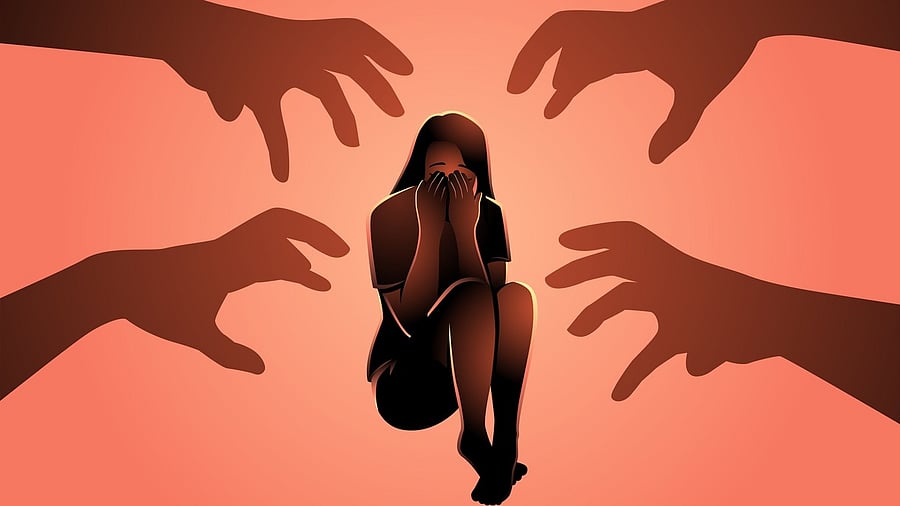
Representative image of crime against women.
Credit: iStock photo
The latest National Crime Records Bureau (NCRB) 2023 data recorded close to 4.5 lakh crimes against women, which was a rise from the previous two years. Cruelty by the husband or relatives (Section 498A) accounted for ~1.34 lakh cases, which shows that domestic violence was the single largest threat to women safety in India.
About 20 years ago, India pledged a simple yet seismic promise: that no woman should be condemned to violence within the sanctuary of her own home. The Protection of Women from Domestic Violence Act, 2005 (PWDVA), came as a thunderclap, shattering generations of silence, stigma, and impunity.
Under the United Progressive Alliance (UPA) government, for the first time in Indian law, the word ‘violence’ reached beyond broken bones and bruises. Under the Act, the home, a supposed haven, stood exposed: violence was not just physical, but emotional, verbal, economic, and sexual.
Mental cruelty, humiliation, financial starvation, and threats, silent weapons used for generations, were called out as crimes deserving redress. Until then, domestic abuse was conveniently buried under dowry laws or left unspoken, as if a woman’s suffering inside her home was somehow acceptable. This was nothing less than a revolution in the Indian legal imagination.
The Act enshrined her right to reside in the shared household, claim financial support, seek protection orders, and, critically, have these rights upheld by civil remedies, swiftly and decisively. It even stretched its arms to include widows, separated women, those in live-in relationships, and daughters, all those whose suffering had, until then, flourished in the legal shadows.
Campaigns like Bell Bajao (Ring the Bell) marked a turning point in India’s fight against domestic violence. Initiated by civil society and powerfully championed by the then government, it wasn’t just a campaign; it called for a national consciousness to be sensitised. The UPA government amplified the message that abuse inside the home is not a private issue; it is a public crisis.
Since then, something powerful and tangible has happened: women have begun to speak. The National Crime Records Bureau (NCRB) data paints the picture: cases of cruelty by husband or in-laws rose from just over 50,000 in 2003 to 1.22 lakh in 2014 and then 1.4 lakh in 2022. This isn’t a spike in violence; this is a surge in courage. Women are reporting. Women are fighting back.
The road ahead remains long and arduous. The underreporting is staggering. According to NFHS-5, one in three married women in India experiences domestic violence. Yet, 80% remain silent, and only 6.3% approach the police. Domestic violence is still taboo. Survivors face character assassination, social ostracism, and humiliation. Instead of support, they encounter doubt, suspicion, and vilification.
The delivery of relief through initiatives like the One Stop Centre (OSC) and shelter homes is brazenly apathetic. Launched in 2015, many OSCs have become mere slogans painted on empty buildings, devoid of staff or facilities. This neglect amounts to extended abuse. The government refuses to put its money where its mouth is. Chronic underfunding, lack of trained personnel, and absent infrastructure plague these centres. What should be safe havens providing medical aid, legal counsel, temporary shelter, police assistance, and psycho-social support remain stuck in limbo.
Adding insult to injury, the government merged multiple women’s safety initiatives, including OSCs, the women’s helpline, and Beti Bachao, Beti Padhao, reducing them to hollow rhetoric. Budget utilisation is abysmal: only 31.2%, 34.7%, and 82.2% of allocated funds were spent in FY 2021-2022, 2022-2023, and 2023-2024, respectively.
With little outreach or promotion, awareness remains shockingly low; just 4%, according to a NITI Aayog study. Shelter homes under the Swadhar Greh Scheme, now merged into Shakti Sadan, languish in deplorable conditions. Poor sanitation, inadequate security, scarce facilities, and official apathy force women away from these supposed safe havens.
Courts compound the crisis. Overburdened and sluggish, they drain survivors of hope and energy. Protection orders often remain on paper, unenforced and ignored. Conviction rates linger in single digits, allowing most perpetrators to roam free, unpunished, and often repeat offenders. Further, understaffed, underfunded, and poorly trained protection officers leave women vulnerable.
Anniversaries demand more than reflection; they demand action. India’s battle against domestic violence calls for a second revolution: one of delivery and cultural change. On the delivery front, the government must ensure that all 812 One Stop Centres are fully operational, with trained staff, sufficient funds, and proper infrastructure, not just existing on paper. Shelter homes must be built and equipped with essential facilities. State governments need adequate funding to train and empower protection officers. Survivors need more than promises; they need boots on the ground: safe shelters, legal aid, medical care, and above all, dignity.
Equally urgent is removing deep-rooted social attitudes. Until women can report abuse without fear of shame or retaliation, and until abusers face a system that stands firmly with survivors, the promise of 2005 will remain painfully incomplete.
The Protection of Women from Domestic Violence Act is India’s vision, a home where safety is a right, not a privilege. The revolution remains unfinished. The law’s words blaze with hope, but only through relentless enforcement, social awakening, and survivor-led activism will India finally dismantle the tyranny of violence within its walls.
Renuka Chowdhury, a former Union Cabinet Minister, is a Rajya Sabha MP from the Indian National Congress. X: @RenukaCCongress.
Disclaimer: The views expressed above are the author's own. They do not necessarily reflect the views of DH.